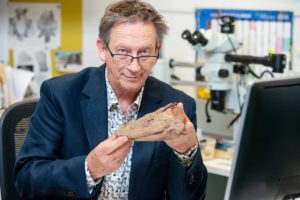
Predatory fish that evolved into the first terrestrial animals on Earth are still revealing insights into the origins of mammals - including new research into the eating habits of lobe-finned fish which inhabited an ancient reef in northern Australia.
In new research in iScience journal, an international study led by Flinders University reveals new insights into the lives of 380-million-year-old lungfish after a high-tech examination of 'remarkable' well-preserved jawbones found in the remote Gogo fossil field in northern Western Australia.
The 3D finite element model (FEM) analysis of the strength and features of fossilised mandible bones was used to evaluate how multiple species co-existed in the tropical prehistoric ecosystem during the Devonian 'Age of Fishes'.
Dr Alice Clement, corresponding author of the new study, says lungfish are 'sister taxa' to the tetrapods – or all four-limbed animals with a backbone, including humans - "which means they are our closest 'fishy' relatives".
"They have an extensive fossil history stretching back over 400 million years and still with living representatives today and their phylogenetic proximity to tetrapods giving insight into our long distant ancestors who first made the move from water to land," she says.

The exceptional Gogo Formation has so far yielded the greatest diversity of lungfishes known from any time or space - with 11 described showing a remarkable diversity of morphologies, particular relating to skull and jaw shape.
Now for the first time the different biomechanical function has been reconstructed - to highlight the diet and predatory powers of the mysterious fish.
"We're slowly teasing apart the details of how the bodies and lifestyles of these animals changed, as they moved from being fish that lived in water, to becoming tetrapods that moved about on land," says Dr Clement.

With Australian and overseas colleagues, the Flinders team included honours palaeontology researcher Joshua Bland, Dr Clement, Professor John Long and biomedical experts in the US including Dr Olga Panagiotopoulou.
"Our comprehensive dataset offers the most detailed quantification of biting performance in any fossil fish thus far, providing biomechanical evidence for diverse feeding adaptations and niche partitioning within Gogo lungfishes," says Dr Panagiotopoulou, from Touro University California.
Based on CT scans of exceptionally-preserved 3D fossils, seven taxa were examined to quantify shape disparity, with FEM used on five which were preserved with associated crania and lower jaws.
"We were then able to model the stress and strain experienced by these lower jaws during biting," she says.
Strategic Professor of Palaeontology John Long says the new study features important information about the specialised way 'gracile' or 'robust' morphology and dentition of their jawbones allowed these fascinating fish to hunt, bite and eat.
"The results were somewhat surprising, with some 'robust'-looking lower jaws appearing to not be all that well suited to biting stress, and some of the more gracile or slender jaws appeared to be able to with strand stress and strain very well," says Professor Long, who previously described the slender long-snouted Griphognathus whitei (or 'duck-billed' lungfish) from the Gogo Formation area.
"This diversity of biomechanical function seen in the Gogo lungfishes suggest that there was niche partitioning and tropic differentiation among lungfishes, possibly accounting for their incredibly high species diversity at this site."

Primitive forms of placoderm and other fish were the dominant predators around the world for about 60 million years before becoming extinct. Some fossil samples of lobe-finned fish found 50-100 years ago can now be studied in more detail with new techniques such as FEM, which is often used in engineering research.
Lead author, Flinders Palaeontology Lab researcher Joshua Bland, adds: "The Late Devonian reefs of the Gogo Formation were a truly unique lungfish community with species possessing a whole host of different behaviours and abilities.

"To capture parts of that story, hidden in the bone, was extremely rewarding. It felt like we lifted the veil on some real functions behind the form. It was impressive to see the more complex morphology perform better in our tests," he says.
The latest research article - 'Comparison of diverse mandibular mechanics during biting in Devonian lungfishes' (2025) by Joshua Bland (Flinders University), Hugo Dutel (University of Bristol & Université de Bordeaux), John A Long (Flinders), Matteo Fabbri (Center of Functional Anatomy and Evolution, Johns Hopkins University School of Medicine, US), Joseph Bevitt (Australian Centre for Neutron Scattering, ANSTO), Kate Trinajstic (Curtin University & WA Museum), Olga Panagiotopoulou (Touro University California) and Alice M Clement (Flinders) - has been published in iScience. DOI: 10.1016/j.isci.2025.112970
This work was funded by the Australian Research Council grant DP 220100825.






